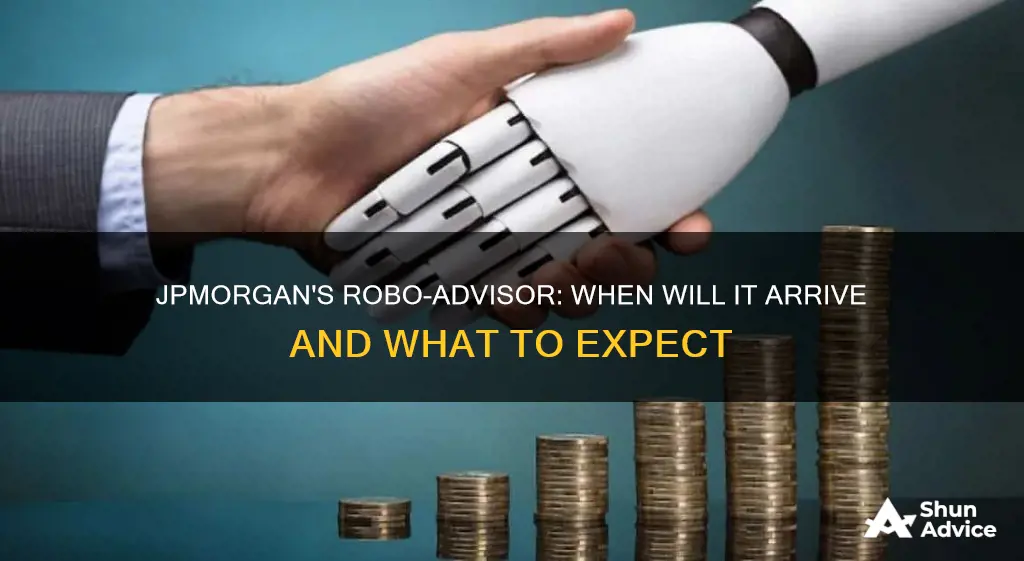
J.P. Morgan Wealth Management has discontinued its robo-advisor service, with all Automated Investing accounts being converted to Self-Directed Investing accounts. The service was shut down due to profitability challenges. While J.P. Morgan Investing offered a basic robo-advisor experience, it lacked certain features such as tax-loss harvesting, and its annual management fee was above average. The robo-advisor service was integrated with other J.P. Morgan products, allowing users to manage their financial life in one place.
| Characteristics | Values |
|---|---|
| Service Status | Discontinued on May 2, 2024 |
| Annual Management Fee | 0.35% |
| Account Minimum | $500 |
| Tools | Limited |
| Investment Options | Stocks, bonds, cash, ETFs |
| Tax-Loss Harvesting | No |
| Account Types | Individual and joint taxable accounts, traditional and Roth IRAs |
| Socially Responsible Portfolio Options | No |
| Automatic Rebalancing | Yes |
| Human Advisor Option | Yes |
| Savings Account/Cash Management Options | Chase Deposit Sweep account with a 0.01% interest rate |
What You'll Learn
- J.P. Morgan's robo-advisor platform offers a basic service for existing customers
- The platform charges higher fees than competitors
- The service is shutting down in Q2 2024
- J.P. Morgan's robo-advisor is best for investors who want portfolio management
- The robo-advisor is integrated with the Chase mobile app

J.P. Morgan's robo-advisor platform offers a basic service for existing customers
J.P. Morgan's robo-advisor platform, J.P. Morgan Automated Investing, offers a basic service for existing customers. The platform is integrated into the Chase mobile app, allowing users to manage their investments alongside their other Chase financial products, such as credit cards and bank accounts. This level of integration can be appealing to those who already have some or all of their financial life at Chase and want the convenience of having everything in one place.
J.P. Morgan Automated Investing provides a basic robo-advisor experience, offering features such as a professionally managed portfolio and automatic rebalancing. When signing up, users fill out a questionnaire to gauge their risk tolerance and goals, and the platform crafts a portfolio based on these answers. The portfolios are classified into four broad categories: Conservative, Moderate, Growth, and Aggressive, with different hypothetical allocations of stocks and fixed income. The platform also offers a "glide path strategy" for retirement accounts, which gradually adjusts the investment allocation to become more conservative as the user approaches their retirement date.
However, J.P. Morgan Automated Investing has been criticised for its above-average annual management fee of 0.35% and limited account types. It also lacks certain features offered by competitors, such as tax-loss harvesting. The platform uses exclusively J.P. Morgan ETFs, which may result in higher fees than other robo-advisors. Additionally, the tools and resources provided by the platform are considered basic and may not offer enough to justify the higher costs for those outside the J.P. Morgan banking universe.
In December 2023, J.P. Morgan announced that it planned to discontinue J.P. Morgan Automated Investing in the second quarter of 2024. Existing customers will have their Automated Investing accounts converted to J.P. Morgan Self-Directed Investing online brokerage accounts, and they will be responsible for managing their own investments.
Avoid These Investment Traps
You may want to see also

The platform charges higher fees than competitors
J.P. Morgan's robo-advisor platform, J.P. Morgan Automated Investing, has been criticised for charging higher fees than its competitors. The platform charges an annual advisory fee of 0.35%, which is higher than competitors such as Betterment (0.25%) and Vanguard Digital Advisor (0.15%). This fee equates to $175 annually on $50,000 invested. Additionally, J.P. Morgan Automated Investing has a minimum balance requirement of $500, while other leading robo-advisors generally have low or no minimums.
The expense ratios of the ETFs that make up the investment portfolios are also a factor in the overall cost of using J.P. Morgan Automated Investing. While some of the ETFs have low expense ratios, such as the JPMorgan BetaBuilders U.S. Equity ETF (0.02%), others charge higher fees, such as the JPMorgan Emerging Markets Equity Core ETF (0.33%) and the JPMorgan Core Plus Bond ETF (0.40%).
When considering the annual advisory fee and the expense ratios of the ETFs, J.P. Morgan Automated Investing is more expensive than other leading robo-advisors. For example, SoFi, a leading robo-advisor, charges no management fees, and Vanguard Digital Advisor costs just 0.15% per year.
It is worth noting that J.P. Morgan rebates the affiliated fee amount from the advisory fee for its in-house ETFs. However, customers will still be responsible for the ETFs if they cancel the robo service and move their assets to a brokerage account.
Overall, while J.P. Morgan Automated Investing may be convenient for existing Chase customers, the platform's higher fees may not be justifiable, especially for those who are not already part of the J.P. Morgan banking universe.
Elon Musk's Dogecoin Dilemma: When Will the Billionaire Back the Meme Coin?
You may want to see also

The service is shutting down in Q2 2024
J.P. Morgan Wealth Management is shutting down its robo-investing service in the second quarter of 2024. The company's Automated Investing program will be discontinued, and all existing customers have been notified of this change. As a result, all Automated Investing accounts will be transitioned to J.P. Morgan Self-Directed Investing online brokerage accounts. This means that customers will be solely responsible for managing their investments and making decisions regarding their accounts. The shift away from robo-investing is a significant change for J.P. Morgan clients, who will now have more control and autonomy over their investment strategies and portfolio management.
The decision to shut down the robo-investing service was announced in December 2023, giving customers several months' notice before the change took effect in Q2 2024. This transition period allows customers to adjust their investment strategies and make any necessary preparations for the shift to self-directed investing. It is important to note that while J.P. Morgan will no longer offer robo-investing as a service, they continue to provide various investment options and wealth management services to their clients.
The move away from robo-investing by J.P. Morgan can be attributed to a variety of factors, including the desire to streamline their service offerings and focus on their core strengths. Additionally, the profitability of operating a robo-advisor service may have been a challenge, as indicated by similar decisions made by other financial institutions. This shift also reflects a growing trend in the industry, with an increasing number of investors seeking more personalized and tailored investment advice.
J.P. Morgan's decision to discontinue their robo-investing service has prompted customers to explore alternative investment platforms that continue to offer this service. Competitors such as Betterment, Wealthfront, and SoFi have emerged as popular choices for investors seeking automated investment management. These platforms offer features such as tax-loss harvesting, low fees, and comprehensive investment tools that appeal to a wide range of investors.
The transition from robo-investing to self-directed investing at J.P. Morgan marks a significant shift in how their clients will engage with the platform. While some customers may embrace the opportunity for more hands-on investment management, others may seek alternative platforms that better align with their investment preferences and goals. This change underscores the dynamic nature of the investment landscape and the diverse needs of investors.
Starbucks: A Brew Worth Betting On
You may want to see also

J.P. Morgan's robo-advisor is best for investors who want portfolio management
The robo-advisor classifies its portfolios into four broad categories: Conservative, Moderate, Growth, and Aggressive. The portfolios are built using eight ETFs, which are then mixed and matched at different weightings.
If you're selecting a retirement account, you'll also be able to use the robo-advisor's "glide path strategy." This strategy gradually moves your investments from an aggressive allocation to a conservative one as you approach your indicated retirement date.
J.P. Morgan's robo-advisor also offers automatic rebalancing, which helps your portfolio stay on track with its target allocations. This feature is standard among robo-advisors but is still worth mentioning.
The mix of funds available at J.P. Morgan Automated Investing is on the lighter side, but it represents the most important asset classes. The robo-advisor can build you a diversified portfolio even if it doesn't use a large number of funds. The eight funds cover the basics: U.S. stocks, REITs, emerging markets, developed markets, and various bond funds.
One downside of J.P. Morgan's robo-advisor is that it doesn't offer tax-loss harvesting, a premium feature typical for robo-advisors that score highly in reviews. Additionally, the annual management fee is above average compared to independent providers.
UPRO: Why Investors Are Not Buying
You may want to see also

The robo-advisor is integrated with the Chase mobile app
The Chase Mobile app has strong reviews on iOS and Google Play, rated 4.8 and 4.4 out of 5, respectively. The app is said to have the basics down and makes it easy to access all your Chase accounts in one place. However, some users have reported issues with logging in and the app crashing.
The robo-advisor platform is also accessible through the Chase website, where users can manage their investments and access various features and resources.
Retirement Readiness: Smart Investing in Your 20s
You may want to see also
Frequently asked questions
The minimum investment required for JPM robo-investing is $500.
The annual management fee for JPM robo-investing is 0.35% of the account balance.
JPM robo-investing supports individual and joint taxable accounts, traditional IRAs, and Roth IRAs.
JPM robo-investing offers an easy-to-use platform, a well-diversified portfolio, and integration with other Chase accounts.
The drawbacks of JPM robo-investing include a high management fee, a high account minimum, and limited tools and features compared to competitors.







